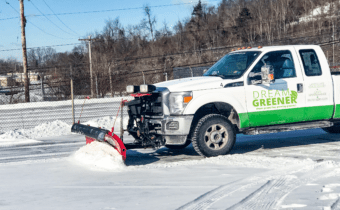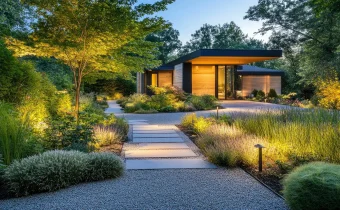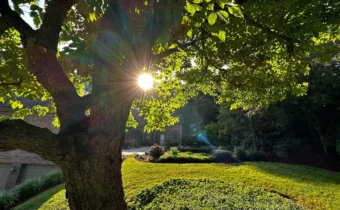As October fades into November in Pittsburgh, homeowners often focus on clearing leaves, aerating lawns, and wrapping up outdoor projects. But don’t overlook one of the most important areas of your yard: your landscape beds. These beds play a critical role in curb appeal, soil health, and the long-term success of your plants.
Taking the right steps now helps prevent winter damage, reduce spring maintenance, and ensure your landscape beds emerge clean, healthy, and vibrant next season. At Dream Greener Lawn & Landscape, we’ve put together a science-backed checklist to guide you through the process. And don’t forget to check out our helpful Pittsburgh Lawn and Landscape Guide!
Remove Weeds and Spent Annuals
Before you add any mulch or compost, you need a clean slate. That means pulling up:
- Weeds (roots and all)
- Dead annuals
- Dying perennials that aren’t worth overwintering
Why now? If left in place, weeds will go dormant and return stronger in spring. Invasive species like ground ivy, chickweed, and creeping Charlie can overwinter easily in Pittsburgh’s climate if not removed.
Tip from Penn State Extension: Removing seed heads and root systems now dramatically reduces weed populations the following spring. Fall is the best time to disrupt their lifecycle.
Cut Back Perennials (Selectively)
Some perennials benefit from fall cutbacks, while others are better left standing for winter protection or pollinator habitats. Cut back now if:
- The plant shows signs of disease or fungal issues (e.g., powdery mildew on peonies or bee balm)
- It tends to mat down and smother new growth (like daylilies or liriope)
- You prefer a tidy appearance
Leave in place if:
- It provides winter interest (ornamental grasses, coneflowers)
- It’s a home for beneficial insects or birds
We recommend using clean, sharp pruners and removing debris to reduce disease and insect overwintering.
Apply a Fresh Layer of Mulch
Mulch isn’t just for aesthetics—it’s a powerhouse for plant protection.
Why mulch in the fall?
- Insulates plant roots against Pittsburgh’s freeze-thaw cycles
- Suppresses winter weed growth
- Prevents soil erosion and nutrient leaching
- Adds organic matter to improve soil health
We recommend a 2–3 inch layer of natural mulch such as brown or black pine bark, shredded hardwood, or composted leaf mulch.
Dream Greener Pro Tip: Dream Greener uses a mulch blower for a clean, even application that reaches tight areas and saves labor time. It’s cleaner, quicker, and more precise than traditional mulching.
Edge Your Beds for a Clean Start to Spring
Neaten up your lawn-to-bed borders now with crisp bed edging. Not only does it improve winter curb appeal, but it also:
- Prevents turf encroachment
- Gives mulch a natural containment edge
- Reduces the need for re-edging in early spring
You’ll appreciate the clean lines and definition when everything starts waking up in March and April.
Add Compost (Optional but Powerful)
Fall is the perfect time to amend your soil. After weeding and edging—but before mulching—you can apply compost topdressing to landscape beds.
Benefits include:
- Improving soil texture and moisture retention
- Increasing microbial activity
- Enhancing spring nutrient availability
For gardens with heavy clay soils (common in many Pittsburgh suburbs), compost is especially helpful for loosening compaction.
Protect Young or Vulnerable Plants
Certain shrubs and perennials may need a little extra TLC:
- Wrap evergreens or boxwoods in burlap to prevent windburn
- Mulch around the root flare of young trees (but don’t pile it against the trunk!)
- Stake tall plants or grasses if snow or ice could cause breakage
A little winter prep goes a long way in preventing costly plant loss and preserving landscape investments.
Final Thoughts: Make It Easy on Yourself (and Spring)
By addressing weeds, bed cleanup, mulch, and plant protection now, you’ll reduce spring cleanup time, improve soil conditions, and enjoy a landscape that looks cared-for all winter long.
At Dream Greener Lawn & Landscape, our fall services are designed with Pittsburgh’s climate and plant palette in mind. From mulch installation to expert plant pruning and compost application, we’re here to help you finish the season strong.
Schedule your fall landscape bed prep and give your property a beautiful—and strategic—head start for spring.
FAQs
Q: Is it better to mulch in the fall or spring in Pittsburgh?
A: Fall mulching helps insulate soil and roots from freeze-thaw cycles and suppresses winter weeds, making it the preferred choice for Pittsburgh’s climate.
Q: Should all perennials be cut back before winter?
A: Not always. Some perennials benefit from fall cutbacks, especially those with disease issues, while others are better left until spring to support wildlife or prevent frost damage.
Q: How thick should mulch be in landscape beds?
A: A 2–3 inch layer is ideal. Too little won’t suppress weeds, and too much can suffocate roots or encourage pests.
Q: Can compost be added to beds in the fall?
A: Yes, fall is an excellent time to apply compost. It enriches the soil, improves structure, and boosts microbial activity before spring growth.
Q: What type of mulch is best for winter protection?
A: Shredded hardwood, pine bark, and composted leaf mulch are great choices for both insulation and soil health in Pittsburgh-area landscapes.



